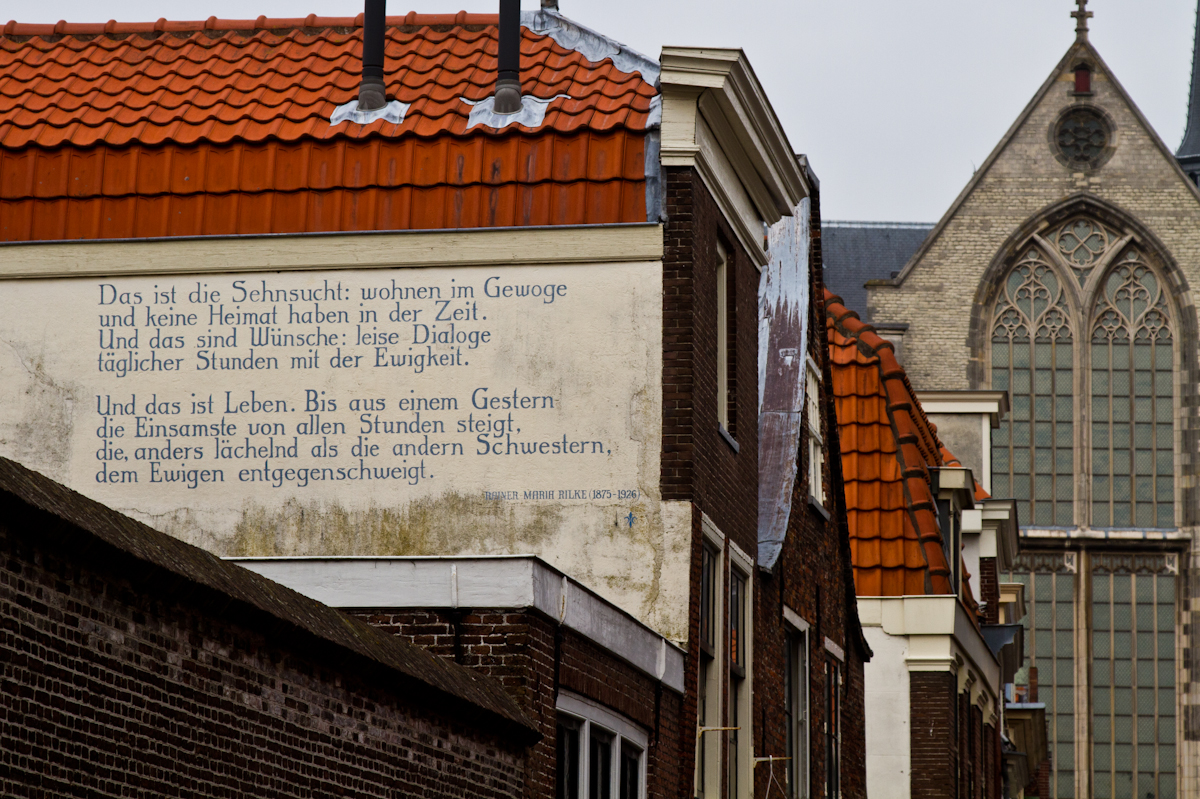Verlangen is: wonen in deining
Verlangen is: wonen in deining,
geen thuishaven vinden in tijd.
En wensen: gesprek vol verfijning
van dagelijkse uren met eeuwigheid.
Het leven. Tot eenmaal door gister
het eenzaamste uur wordt omkaderd
dat - verschil in het glimlachen is-t-er -
Het eeuwige zwijgend benadert.
Vertaling: Jaap Blom
Listen to this poem in German.
Voiced by: Lea Grüter
This poem in 60 seconds
Rilke is known as ‘the poet of the Sehnsucht’, hopeless yearning. He owed his reputation to poems such as this one, in which he caught this emotion. Sehnsucht feels like living in turmoil, like loneliness and timelessness, like life itself.
Want to know more? On this website you can listen to the poem, discover its origins and its author and find out what the poem means to the people of Leiden.
Rainer Maria Rilke
Prague 1875 - Montreux 1926
Rainer Maria Rilke was born in Prague as René Rilke. The previous year, his sister had died shortly after birth and his grieving mother therefore raised him as a girl until he was six. His parents separated when he was nine years old and sent him to a military academy in Austria. Sensitive René felt like he did not belong and dropped out of school. He received private education and afterwards studied literature, art history and philosophy in Prague and Munich. During his studies, he changed his name into Rainer, because it sounded more masculine and German, and it symbolized him parting from his family.
Personal life
For three years, Rilke had an intense love relationship with Lou Salomé, a married, fifteen years older Russian-German philosopher, psychoanalyst and writer. Psychiatrist Sigmund Freud, Lou’s supervisor, wrote about her that ‘she was both muse and caring mother to the great poet Rainer Maria Rilke, who was helplessly navigating through life.’ In 1901, Rilke married sculptress Clara Westhoff and in that same year, their daughter Ruth was born. However, not much later he left his family and set out to Paris.
Work
‘There is so much more reality in a poem I created than I feel in any relationship or affection’, Rilke wrote in 1903. ‘Where I work, I am true and I would like to find the strength to found my entire life on that truth.’ For him, writing novels and poems meant fleeing from reality. For years, Rilke led a roaming life in Germany, Russia, Italy, France and Switzerland, where he died of leukemia.
What's this poem about?
This poem is about Sehnsucht, a nearly untranslatable term that comes down to such an intense yearning for something that one can speak of suffering. This poem clarifies what Sehnsucht feels like: as if you are continuously thrown back and forth and you never feel at home. It is a feeling of loneliness that seems to last forever and is omnipresent.
Origin story
In 1899, Rilke’s collection Mir zur Feier appeared, the first in which all poems were about emotion. For every poem, he accurately stated the date and place of writing. This poem was created on 3 November 1897 in Berlin-Wilmersdorf, when Rilke was 22 years old. It was the first poem of the collection. At that time, it did not have the title Das ist die Sehnsucht, but it was the motto found at the beginning of the collection. With this, Rilke made clear that this poem represented the attitude towards life that would reappear throughout the entire collection: Sehnsucht.
Share your story
Does this poem hold a special place in your heart? For example, do you remember when you first read the poem? Or did you come across it someplace unexpected? Let us know at muurgedichten@taalmuseum.nl! We would love to add your story to our website.
Rainer Maria Rilke in Leiden

Photo Inge Harsten
This wall poem can be found at Herensteeg 39 in Leiden since 1993. It was the 11th wall poem that was realized by the TEGEN-BEELD Foundation. In 1999, it disappeared for a short period of time, because the facade needed to be renovated. Afterwards, it was repainted.
Quotes
I find this to be the most eminent duty of a bond between two people: each protects the loneliness of the other
Rainer Maria Rilke
Fun facts
- Rilke was a passionate and obsessive writer of letters. He entered into lengthy correspondences, his legacy consists of 12,000 letters. He did not only write to lovers, friends and acquaintances, but also to strangers who asked him for advice.
- In 1905-06, Rilke was the secretary of sculptor Auguste Rodin. He was deeply impressed by his work. Rodin also learned him to look at art differently. Before, Rilke’s poems were filled with emotion, but now, he chose an object from nature that he – after intense observation – reduced to the most essential, the core.
That is longing: living in turmoil
That is longing: living in turmoil
and having no home in time
and those are wishes: gentle dialogs
of day's hours with eternity
And that is life. Until out of a yesterday
the most lonely hour rises
which, smiling differently than the other sisters (hours)
silently encounters eternity
Translation: Jan and Allan van Asselt
Das ist die Sehnsucht
Das ist die Sehnsucht: wohnen im Gewoge
und keine Heimat haben in der Zeit.
Und das sind Wünsche: leise Dialoge
täglicher Stunden mit der Ewigkeit.
Und das ist Leben. Bis aus einem Gestern
die einsamste Stunde steigt,
die, anders lächelnd als die andern Schwestern,
dem Ewigen entgegenschweigt.
Learn more
This entry was written by Het Taalmuseum in collaboration with Saskia Kanij. The translation into English is by Jasmijn van Dongen. The following sources were consulted:
- Rainer Maria Rilke, Zijn leven en werk door Wolfgang Leppman, 1990
- Raadsels van Rilke, Paul Claes, 1996
- Auguste Rodin, Rainer Maria Rilke, 1913
- Rainer Maria Rilke - Lou Andreas-Salomé. Briefwechsel Insel Verlag 1975: 96.
- Honger naar het absolute / beschouwingen over dichters als grensgangers, Johan Reijmerink, 2007
- Rilke.de
